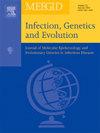通过扩增子测序评估加纳北部和南部恶性疟原虫的遗传多样性和感染的多样性
IF 2.6
4区 医学
Q3 INFECTIOUS DISEASES
引用次数: 0
摘要
疟疾是加纳面临的一项重大公共卫生挑战,恶性疟原虫占感染病例的80 - 90%。本研究旨在确定加纳北部和南部不同的气候条件、人口统计、传播模式和控制措施是否会导致恶性疟原虫遗传多样性、种群结构和进化动态的差异。使用扩增子测序方法分析了2018年和2021年收集的354份临床样本,针对CSP, AMA1, SERA2和TRAP基因。加纳北部和南部的寄生虫种群均表现出较高的单倍型多样性(Hd = 0.93-0.98)。超过70%的患者样本含有多克隆感染,感染的多重性在加纳北部(2.91)明显高于南部(2.42)。尽管存在这样的差异,但广泛的单倍型共享被观察到。单倍型网络和系统发育分析强调了寄生虫种群之间的大量遗传连通性,可能是由多种因素驱动的,包括人类运动和共享载体。优势单倍型在不同地区和年份具有一致性,反映了核心单倍型的稳定库,不受当代控制措施的显著影响。总之,本研究强调了加纳恶性疟原虫种群的高度遗传多样性和连通性,尽管传播生态不同,实施的控制措施也不同。本文章由计算机程序翻译,如有差异,请以英文原文为准。
Plasmodium falciparum genetic diversity and multiplicity of infection in northern and southern Ghana assessed by amplicon sequencing
Malaria is a significant public health challenge in Ghana, with Plasmodium falciparum accounting for 80–90 % of infections. This study aimed to determine whether different climatic conditions, demographics, transmission patterns, and control practices in northern and southern Ghana result in differences in the genetic diversity, population structure, and evolutionary dynamics of P. falciparum. A total of 354 clinical samples collected in 2018 and 2021 were analyzed using the amplicon sequencing approach, targeting the CSP, AMA1, SERA2, and TRAP genes. Parasite populations from both northern and southern Ghana exhibited high haplotype diversity (Hd = 0.93–0.98). More than 70 % of the patient samples contained multiclonal infections, and the multiplicity of infection was significantly higher in northern (2.91) than in southern Ghana (2.42). Despite such a difference, extensive haplotype sharing was observed. The haplotype network and phylogenetic analyses highlighted substantial genetic connectivity among the parasite populations, likely driven by multiple factors, including human movement and shared vectors. Predominant haplotypes were consistent across regions and years, reflecting a stable pool of core haplotypes, which was not significantly impacted by contemporary control measures. In conclusion, this study underscored the high genetic diversity and connectivity of P. falciparum populations in Ghana despite different transmission ecology and the implementation of divergent control measures.
求助全文
通过发布文献求助,成功后即可免费获取论文全文。
去求助
来源期刊

Infection Genetics and Evolution
医学-传染病学
CiteScore
8.40
自引率
0.00%
发文量
215
审稿时长
82 days
期刊介绍:
(aka Journal of Molecular Epidemiology and Evolutionary Genetics of Infectious Diseases -- MEEGID)
Infectious diseases constitute one of the main challenges to medical science in the coming century. The impressive development of molecular megatechnologies and of bioinformatics have greatly increased our knowledge of the evolution, transmission and pathogenicity of infectious diseases. Research has shown that host susceptibility to many infectious diseases has a genetic basis. Furthermore, much is now known on the molecular epidemiology, evolution and virulence of pathogenic agents, as well as their resistance to drugs, vaccines, and antibiotics. Equally, research on the genetics of disease vectors has greatly improved our understanding of their systematics, has increased our capacity to identify target populations for control or intervention, and has provided detailed information on the mechanisms of insecticide resistance.
However, the genetics and evolutionary biology of hosts, pathogens and vectors have tended to develop as three separate fields of research. This artificial compartmentalisation is of concern due to our growing appreciation of the strong co-evolutionary interactions among hosts, pathogens and vectors.
Infection, Genetics and Evolution and its companion congress [MEEGID](http://www.meegidconference.com/) (for Molecular Epidemiology and Evolutionary Genetics of Infectious Diseases) are the main forum acting for the cross-fertilization between evolutionary science and biomedical research on infectious diseases.
Infection, Genetics and Evolution is the only journal that welcomes articles dealing with the genetics and evolutionary biology of hosts, pathogens and vectors, and coevolution processes among them in relation to infection and disease manifestation. All infectious models enter the scope of the journal, including pathogens of humans, animals and plants, either parasites, fungi, bacteria, viruses or prions. The journal welcomes articles dealing with genetics, population genetics, genomics, postgenomics, gene expression, evolutionary biology, population dynamics, mathematical modeling and bioinformatics. We also provide many author benefits, such as free PDFs, a liberal copyright policy, special discounts on Elsevier publications and much more. Please click here for more information on our author services .
 求助内容:
求助内容: 应助结果提醒方式:
应助结果提醒方式:


